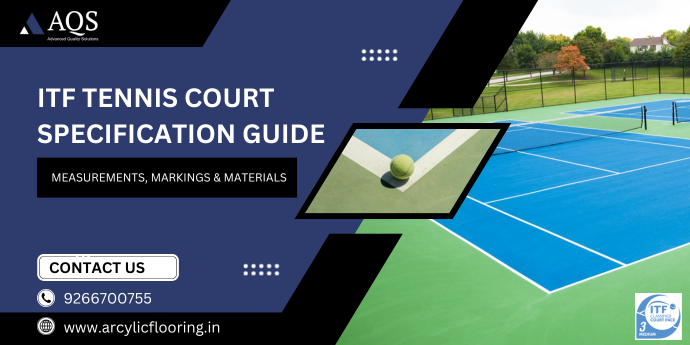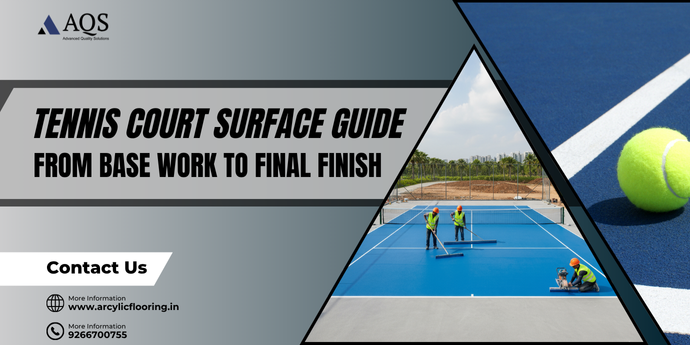Building a tennis court flooring is not just a civil project it’s a legacy. Whether it’s for a school to nurture young athletes, a private club to upgrade its facilities or a township to promote community fitness, a professionally built tennis court converts open land into a platform of performance, passion and precision.
In India where climate is extreme, monsoon is heavy and sunlight is harsh synthetic acrylic tennis court flooring has emerged as the most reliable and durable option. It has elasticity, UV resistance and long term color stability to ensure play in every season. But great material needs equally great craftsmanship.
That’s where AQS comes in. As one of India’s leading tennis court builders, AQS provides scientifically engineered synthetic tennis court materials designed for Indian conditions. Every layer from asphalt base to acrylic topcoat is precision formulated for durability, comfort and consistent bounce.
1. Laying the Vision: Why Build a Tennis Court?
Building a tennis court is more than just a sports facility it’s a symbol of quality, community and active living. A professionally designed court turns any property into a recreation, training and social hub. For schools and educational institutions it’s discipline and physical fitness for students and structured sports programs. Residential societies see it as a premium amenity that increases property value and community bonding. Sports clubs, academies and private facilities get a competitive edge by having world class infrastructure that attracts memberships and tournaments.
AQS designs synthetic tennis court material systems for Indian climate, with UV stable resins, moisture resistant primers and flexible cushion layers that expand and contract with temperature changes. This ensures long term adhesion, even texture and consistent ball bounce year after year. By choosing AQS systems, builders, developers and sports institutions don’t just build a court they invest in a surface built for performance, durability and excellence.
AQS helps turn every vision whether it’s a school sports ground, a professional academy or a residential recreation area into a world class tennis experience that lasts for decades.
2. Site and Base Selection
The first step in any tennis court construction is site selection. Perfect site should be level, well drained and align to reduce sun glare. A slope makes sure good drainage during heavy rain.
Base Options: Concrete vs. Asphalt
AQS recommends two main bases for tennis hard court material:
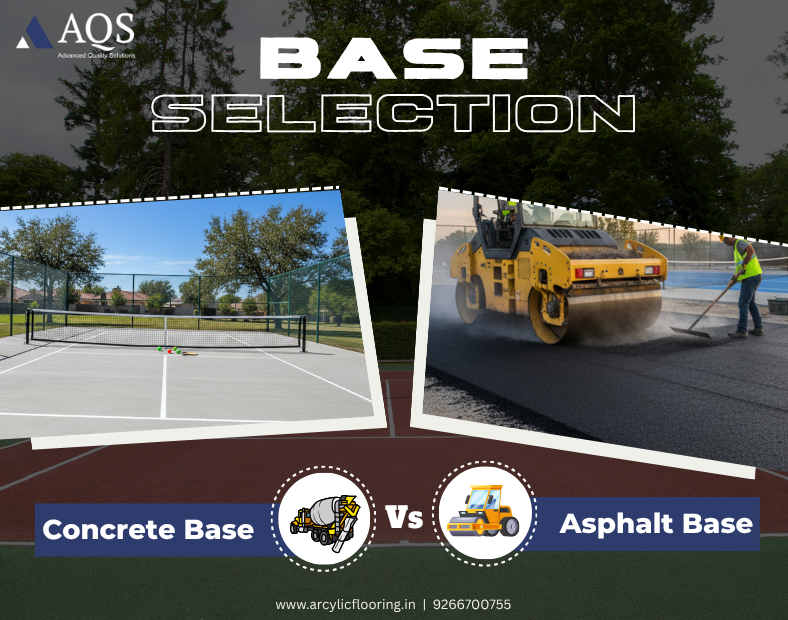
- Concrete Base: Unbeatable strength, dimensional stability and long life, concrete bases are ideal for permanent tennis court facilities that require precision and durability.
- Asphalt Base: Quicker to install and more flexible, ideal for multi-court setups or budget conscious projects, especially in institutional and community areas.
Both bases work perfectly with AQS synthetic acrylic tennis court flooring systems, for superior adhesion once the surface is fully cured, moisture free and coated with AQS high-bond primer for long term performance.
3. Tennis Court Dimensions
The ITF-3 has set standards for all professional and recreational tennis courts. These dimensions ensure equality for all tennis courts worldwide so players can train and compete under the same conditions.
- Singles Court: For one on one matches where precision, baseline rallies and sidewise control are key. The narrower width requires more accurate shot placement and player endurance.
- Doubles Court: More width for teamwork, communication and angled shots. The added alleys make doubles a test of positioning and quick reflexes.
- Total Play Area: Minimum 2,808 sq.ft for singles and 3,600 sq.ft for doubles for fair play and ball path. Plus a 12 ft buffer zone behind each baseline and 6 ft on each side for safety and comfort, reducing collision risk and improving playability on all surfaces.
These dimensions are set in professional tennis court construction and AQS makes sure every court meets ITF standards from first serve to last point.
4. The Science Behind AQS Surfaces
The performance of any tennis court starts with the surface the layer that defines speed, comfort and safety. AQS synthetic acrylic tennis court flooring combines material innovation and precision engineering to deliver consistent bounce, weather resistance and long lasting appeal.
AQS Material Features:
- UV Resistant: AQS uses high quality, UV resistant acrylic resins that maintain colour and gloss even after years of sun exposure.
- Concrete Primers: Concrete primers stick deep into the base, creating a strong chemical bond between the slab and coating layers.
- Cushion Coats: These are engineered with micro rubber particels that deliver controlled elasticity and shock absorption.
- ITF Rated Material: Top finishing coats are ITF pace rated, friction tested and surface uniformity tested.
Each layer of synthetic tennis court material from resurfacer, cushion to colour coat is designed to work together. Together they provide the perfect combination of performance, aesthetics and longevity so every serve, rally and sprint on an AQS tennis court flooring system feels professional and consistent year after year.
5. Customization: Colors, Logos, Pace Ratings
Every tennis court is more than just a play surface it’s a statement. With AQS tennis court flooring, customization combines design with performance so clubs, academies and developers can create surfaces that match their brand and enhance playability.
- Popular Combinations: Classic choices like blue-green, red-green, blue-purple not only look great but also improve ball visibility and player focus. Each colour combination is engineered with UV stable pigments that won’t fade even in extreme sunlight.
- Logo Integration: With AQS synthetic acrylic coatings, branding is easy. Club names, school emblems or sponsor logos can be integrated seamlessly using weather resistant court paints that stick to the surface.
- Pace Options: Different players, different preferences AQS has slow, medium or fast ITF pace rated systems to suit every playing style. Slow courts are for endurance and rallies, fast courts are for aggressive serves and volleys.
The result? A court that performs, looks great and reflects the people who play on it crafted with precision, passion and AQS performance technology.
6. The Tennis Court Cost Factor:
The tennis court construction cost in India depends on many factors surface system, base material, size, location and finishing features. The total cost includes preparation, coatings and professional labor, all of which affects long term durability and performance.
Here’s a general idea for India:
| Component | Cost Range (₹) |
|---|---|
| Base Layer | ₹8,00,000 – ₹9,00,000 |
| 5 Layer | ₹4,00,000 – ₹5,00,000 |
| 8 Layer | ₹5,00,000 – ₹6,00,000 |
These costs are for material, labor and application of main playing surface. Does not include optional upgrades like fencing, lighting, seating or specialized drainage system.
AQS ensures 100% transparency by providing customized quotes based on site size, location and surface specification so every rupee is accounted for quality, performance and longevity.
7. Drainage, Fencing & Lighting Setup
A tennis court isn’t complete without the right support infrastructure. From drainage to fencing and lighting, every detail matters.
- Drainage: Slope with side channels makes sure rainwater flows away smoothly, no surface damage or bubbles. Proper drainage for synthetic acrylic tennis court surface.
- Fencing: High quality fencing keeps the tennis court safe and organized. Chain link fencing with PVC coating stop rust, wind pressure and ball impact.
- Lighting: For evening or indoor play, proper lighting is important for visibility and player comfort. LED floodlights provides brightness across the tennis court without glare or shadows.
From base work to finishing touches like fencing and lighting, everything is taken care of so the tennis court is built for durability, looks and performance.
8. Maintenance Tips for Court’s LongLife
Regular maintenance not only preserves playability but also surface life and player safety. Follow these maintenance tips to keep your tennis court flooring in top shape:
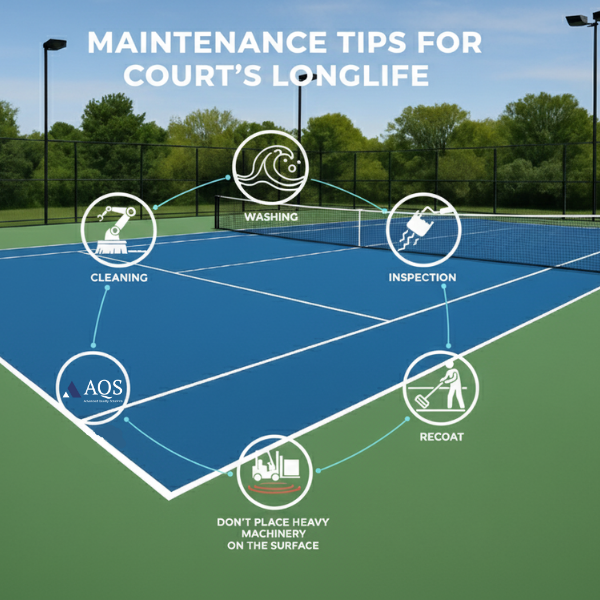
Cleaning: Regular cleaning stop dust, sand and leaves from collecting into the surface texture which can make the tennis court slippery and dull. Use soft brooms or air blowers to sweep debris without scratching the acrylic layers. Regular cleaning also maintains surface color and reduces water seepage during monsoons.
Washing: Occasionally washing the surface removes dirt, sweat and algae buildup. Use a mild detergent mixed with clean water and a soft brush to scrub problem areas. Never use strong acids as they can weaken the acrylic coating and fade the tennis court surface color over time.
Inspection: Yearly inspection detects minor cracks, uneven patches or fading color coats. These issues early stops moisture and costly resurfacing later. AQS recommends scheduling professional inspections once or twice a year especially before and after monsoon season.
Recoat: Applying a fresh AQS Color Coat every 5–6 years restores bounce, grip and vibrant looks. This recoat also refresh the anti-glare finish and maintains ITF approved surface quality.
Don’t Place Heavy Machinery on the Surface: Tennis courts are for sport not for load bearing activities. Parking vehicles, dragging benches or moving sharp tools can damage the acrylic layers and leave permanent marks.
Regular cleaning, inspection and recoating makes sure synthetic acrylic tennis court flooring performs at its best. With minimal maintenance AQS systems keep their original pace, comfort and traction every game feels like the first serve.
Build Professional Tennis Court with AQS
AQS flooring systems are built to withstand extreme heat, monsoon humidity and UV exposure. Each layer is flexible yet strong, stop to cracks and fading in outdoor conditions. High performance coatings make sure smooth play and consistent ball response throughout the year.
Made in India with International Standards: AQS offers a complete surface system developed with local manufacturing and global quality control. From concrete primer to color topcoat, every material meets ITF-3 and ISO standards.
ITF Rated Materials: Each AQS product undergoes pace and friction testing to meet international playability standards. The result is a balanced tennis court surface that provides ball bounce, excellent grip and player comfort. Whether its for practice academies or tournament venues, system supports professional level performance.
Proven Performance: AQS materials have been used in many institutional and public sports infrastructure projects in India. From school playgrounds to national academies, the surfaces retain their finish and pace for years.
Expert Guidance: Beyond materials, AQS provides technical support on choosing the right base type concrete or asphalt tennis court and makes sure proper slope, drainage and protection. Their engineering support stops issues like bubbles, cracks and delamination and extends the tennis court’s life significantly.
AQS doesn’t just sell products it delivers tested, proven systems that redefine sports flooring in India. Every layer is deliver long term fixing, UV stability and perfect grip-to-glide balance that makes sure player safety and performance. With AQS, every tennis court is a statement of craftsmanship and durability.
Conclusion:
A tennis court is more than a surface it’s where effort meets excellence, and every bounce defines skill. Behind every smooth serve and sharp volley lies a system designed for performance and built to last.
By choosing AQS synthetic tennis court materials, every project gets quality, consistency and international play standards. From base preparation to final line marking, every stage of tennis court construction is backed by science and built to last.
For developers, academies, schools or government sports programs looking for sustainable value AQS delivers performance and durability. Our tennis court flooring systems turn empty ground into professional grade courts that produce champions and serve communities for years.
Frequently Asked Questions
Professional tennis courts use synthetic acrylic layers – primer, resurface, cushion coat and color coat for long lasting play.
Cost of building a tennis court in India ranges from ₹6.5 lakh to ₹12 lakh depending on base type and surface system.
Synthetic acrylic tennis court flooring is the best for outdoor use as it is UV resistant, smooth bounce and all weather durables.
A well-maintained synthetic tennis court can last 10-15 years with regular cleaning and recoating.
Concrete or asphalt base with proper drainage and slope is the ideal base for acrylic court systems.

